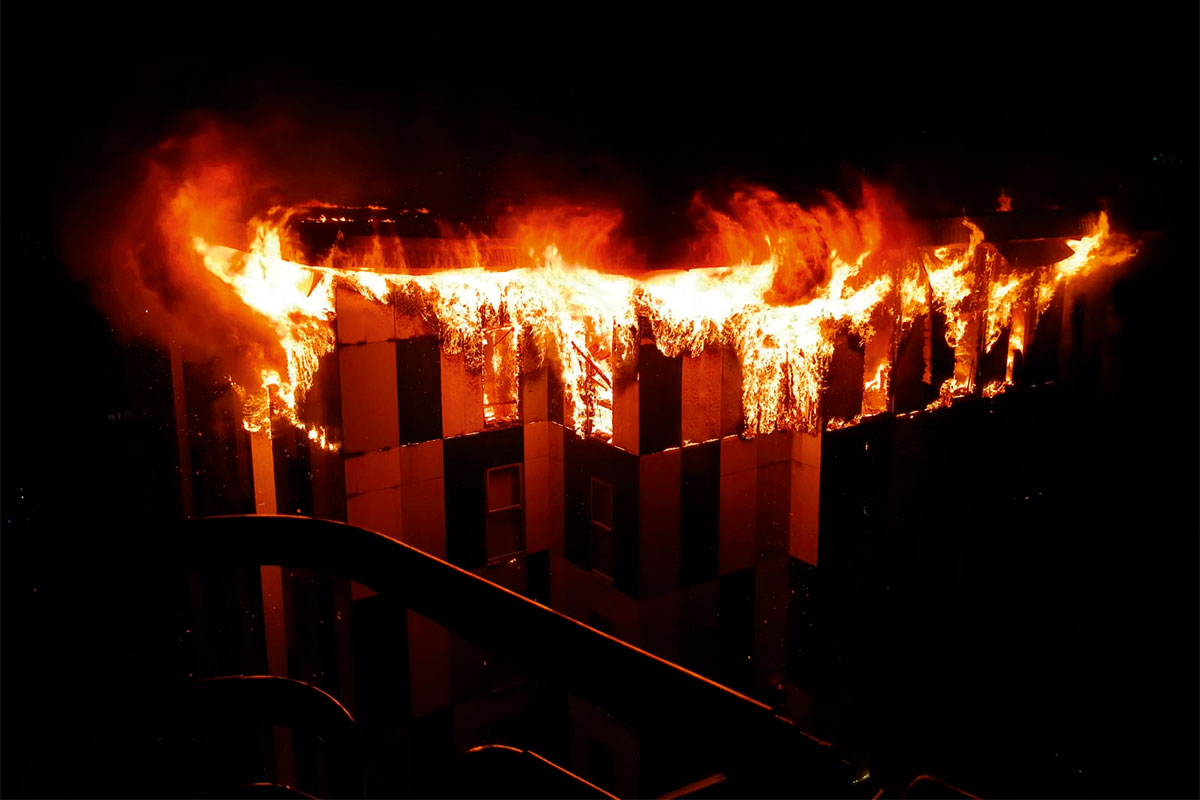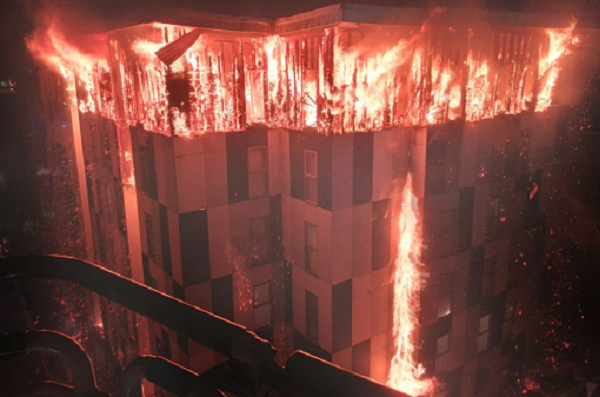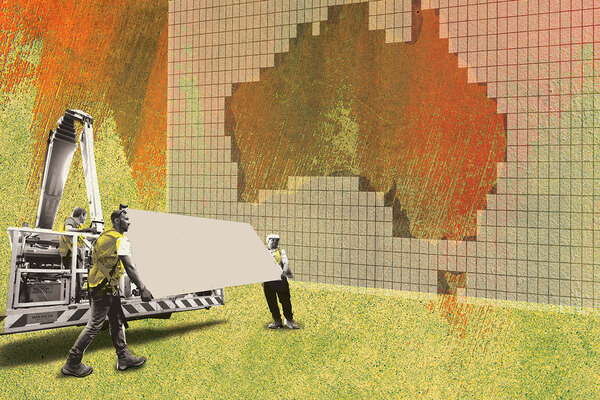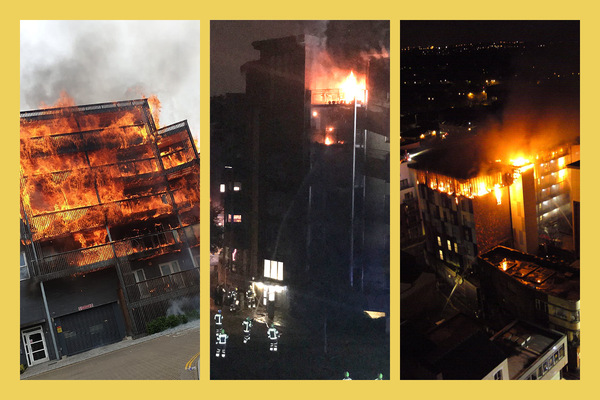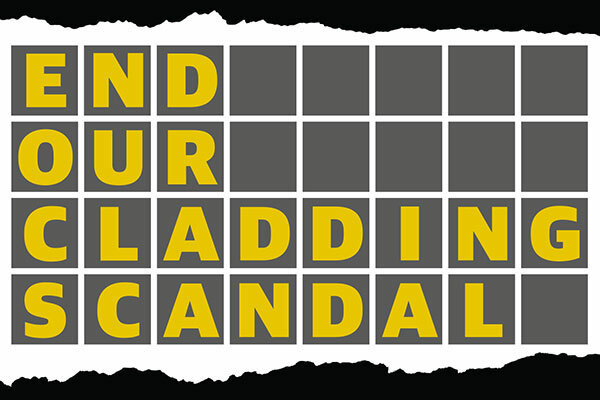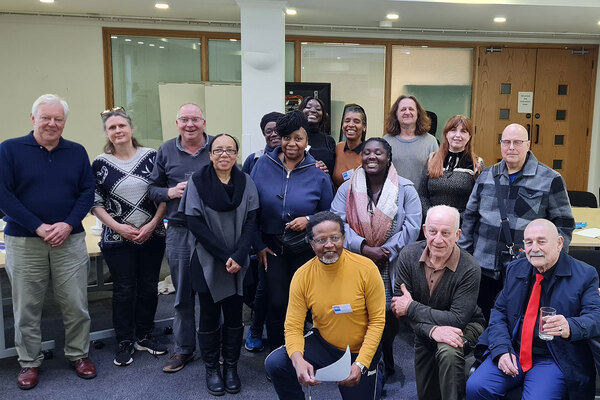It’s only a matter of time until the next Bolton unless the parties step up to the plate on fire safety
Inside Housing’s new election campaign calls on the main political parties to commit to taking action to prevent what currently seems like an inevitable further tragedy. It’s time for everyone to step up, writes Martin Hilditch
The fire that ripped quickly through the upper floors of The Cube student halls of residence in Bolton last Friday night (see above) told us absolutely nothing new about the risks posed by residential buildings in the UK.
If you were even mildly surprised when you watched footage of the swift spread of the blaze, well, where have you been hiding for the past two-and-a-half years? Perhaps the headquarters of the Ministry of Housing, Communities and Local Government.
Frankly, the emotion that the fire in Bolton should prompt is anger. Make no mistake, we are stumbling towards another disaster in which multiple lives will be lost.
That doesn’t have to be where we end up. It’s not inevitable. These fires are the result of years of buck-passing that has to stop. That is why Inside Housing has this week updated its End Our Cladding Scandal campaign to call on all parties to step up to the plate and commit to taking action to address the national crisis of dangerous cladding. We argue that the current decentralised approach is failing and will ultimately lead to further tragedy.
We think there are two steps that parties should commit to. First, the creation of a taskforce that would identify the most at-risk buildings of any height and material combination, which would then be prioritised for remedial work, similar to the state taskforce established by the Victorian government in Australia, following the Lacrosse Tower fire in Melbourne in November 2014. In Victoria the taskforce has audited all 2,000 buildings above three storeys and ordered some building owners to carry out work. With this in mind it is pleasing to hear that the government is piloting a ‘protection board’ to take responsibility for the safety of tall buildings with Grenfell-style cladding – but this should be expanded.
Our second call is for the creation of a building safety fund which would help pay for the remediation work based on advice from the taskforce – and wouldn’t be restricted to buildings with Grenfell’s aluminium composite material cladding that are above 18m in height. Most recent fires have been in buildings below 18m, which is the height at which restrictions on the use of combustible materials kicks in. In his report following the first phase of the Grenfell Inquiry, Sir Martin Moore-Bick noted that requirements in Scotland relate to buildings over 11m tall – and said that the second phase of the inquiry will consider whether a new height should be adopted in England).
As a reminder about why it is important for someone to grasp the nettle, over the past few months we have seen the timber-framed Richmond House, in south-west London, destroyed in a fire that spread rapidly in the early hours of the morning (with chance appearing to play a major part in the fact there were no casualties). In August, the Beechmere residential home in Crewe burned to the ground and in June there was the fire that spread rapidly across the wooden balconies and decorative cladding in Barking’s Samuel Garside House.
It is only a matter of time until the next fire. We ask all the parties to take responsibility and commit to doing what they can to prevent a further disaster.
Martin Hilditch, editor, Inside Housing
End Our Cladding Scandal: campaign asks
The next government must:
- Create a ‘building safety fund’ to help pay for the necessary remediation work to affected buildings in the social and private sector – not just those with ACM cladding and above 18m
- Set up a taskforce, with the involvement of residents, capable of inspecting buildings, prioritising and ordering work and ensuring leaseholders are protected from unnecessary costs
End Our Cladding Scandal general election campaign: full coverage
The cladding scandal is far from over. Here’s why we need a fresh approach
Click here to read the full story
Ahead of the general election, Inside Housing revisits our national cladding scandal and sets out what needs to be done to prevent any further tragedies. Peter Apps reports.
The cladding crisis Down Under: what we can learn from the response to Grenfell in Australia
Click here to read the full story
Five years ago a fire spread up Grenfell-style ACM cladding on a high-rise in Melbourne. This prompted an overhaul of the Australian state of Victoria’s building safety regime. Peter Apps finds out what the UK could learn.
More than 100,000 buildings outside scope of fire safety measures, minutes reveal
Click here to read the full story
There are more than 100,000 medium-rise homes that fall outside new regulations aimed at making buildings safe in the aftermath of Grenfell, including the ban on combustible cladding, Inside Housing can reveal.
It’s only a matter of time until the next Bolton unless the parties step up to the plate on fire safety
Click here to read the full story
Inside Housing’s new election campaign calls on the main political parties to commit to taking action to prevent what currently seems like an inevitable further tragedy. It’s time for everyone to step up, writes Martin Hilditch.
Leaseholders fear missing out on £200m cladding fund as bidding deadline approaches
Click here to read the full story
Leaseholders living in blocks seeking government funding for the removal of Grenfell-style cladding have raised concerns over meeting the deadline for applications, while criticising the lengthy process being run by the government.
Government refusing to test polystyrene panels, despite request from London boroughs
Click here to read the full story
The government has no further plans to carry out testing of cladding products despite a specific request from London boroughs to test systems comprising polystyrene, a document obtained by Inside Housing has revealed.

